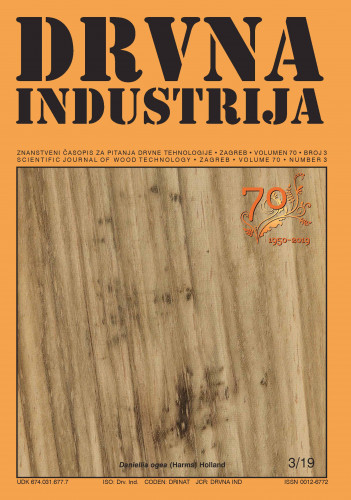U radu su ispitane vibracije peteroslojnih međukatnih križno lameliranih drvenih panela visine 14 cm izazvane ljudskim djelovanjem. Analizirana su tri međukatna panela identičnih visina, ali s različitim kombinacijama debljine lamela u križnim slojevima variranjem njihovih raspona. Navedeni su bitni kriteriji što ih pri projektiranju treba zadovoljiti međukatna konstrukcija da bi se osiguralo njezino prihvatljivo ponašanje u uvjetima dinamičkog opterećenja. Izračun efektivne krutosti na savijanje panela obavljen je Gamma metodom, K-metodom i Kreuzingerovom analogijom. Analitički je određena osnovna frekvencija vibriranja svakog panela, kao i maksimalni progib zbog jedinične statičke sile, a dobiveni su rezultati uspoređeni s vrijednostima dobivenim modalnom i statičkom analizom u programskom paketu Ansys. Svi su dobiveni podatci uspoređeni s važećim kriterijima i selektirani su paneli koji ispunjavaju kriterije sa stajališta graničnog stanja uporabivosti. Rezultati su pokazali da su analizirani međukatni paneli raspona do 4,5 m prihvatljivi sa stajališta adekvatnoga dinamičkog ponašanja pri ljudskom djelovanju. Rezultati su također pokazali da su kombinirani kriterij i kriterij maksimalnoga dopuštenog progiba zbog jedinične statičke sile znatno stroži od kriterija minimalne vrijednosti osnovne frekvencije vibriranja.; This paper investigates the vibrations caused by human action of five-layer cross-laminated timber panels with a height of 14 cm. Analysis is made of three floor panels of identical height, but with different combinations of thicknesses of the laminas in cross-layers, varying their spans. The longitudinal layers of the panels have better physical and mechanical characteristics than transverse layers. The relevant criteria to be observed in floor construction at the designing stage are specified in order to ensure acceptable behavior regarding the dynamic load. Limit values are also given. As it is very difficult to determine the threshold of human acceptability, since vibrations that someone finds disturbing do not have to be disturbing for others, the relevant criteria used in the work has been chosen on the basis of the highest representation in the literature: Natural Frequency Limit, Unit Load Deflection Limit and the Combined Criterion. Calculation of the effective bending stiffness of the panel was performed using Gamma method, K-method and Kreuzinger analogy. The natural frequency of each panel was determined analytically, and so was the maximum deflection due to unit static force and the obtained results were compared with the values obtained by modal and static analysis in the Ansys software package. All the obtained data were compared with the valid criteria, and panels that meet the criteria in terms of the serviceability limit state were selected. The results showed that the analyzed floor panels of the span up to 4.5 m are acceptable in terms of adequate dynamic behavior related to human action according to all criteria. Also, the results showed that the Combined Criterion and the Unit Load Deflection Limit are significantly stricter due to the unit static force compared to the Natural Frequency Limit.
Sažetak

 Drvna industrija : znanstveni časopis za pitanja drvne tehnologije : 70,3(2019) / glavni i odgovorni urednik Ružica Beljo-Lučić.
Drvna industrija : znanstveni časopis za pitanja drvne tehnologije : 70,3(2019) / glavni i odgovorni urednik Ružica Beljo-Lučić.